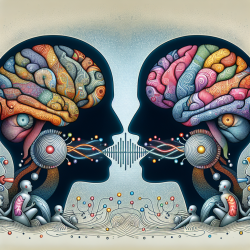Introduction
In the realm of speech-language pathology, understanding the nuanced interplay between various neurodevelopmental conditions is crucial for developing effective intervention strategies. A recent study titled "Perceptual processing links autism and synesthesia: A twin study" offers valuable insights into the relationship between Autism Spectrum Condition (ASC) and synesthesia. This research underscores the importance of perceptual processing in understanding these conditions, providing practitioners with data-driven insights to enhance their therapeutic approaches.
Understanding the Study
Conducted by Neufeld et al. (2021), the study explores the connection between synesthesia—a condition where sensory stimuli lead to additional sensations—and autism. The research involved a predominantly non-synesthetic twin sample, enriched for ASC and other neurodevelopmental disorders, to examine the association between synesthesia and autistic traits. The study's twin design allowed for a controlled examination of shared factors such as genetics and family background.
Key Findings
- Association with Autistic Traits: The study found that a higher degree of synesthesia was linked to increased autistic traits, particularly within the attention to details domain.
- Sensory Sensitivity: There was a notable association between synesthesia and sensory hyper-sensitivity, but not hypo-sensitivity.
- Visual Perception: Individuals with a higher degree of synesthesia demonstrated better ability in identifying fragmented images.
Implications for Practitioners
For practitioners in the field of speech-language pathology, these findings highlight the importance of considering sensory processing characteristics when working with children diagnosed with ASC. Here are some actionable insights:
- Enhanced Assessment: Incorporate assessments that evaluate sensory processing and perceptual skills, especially focusing on attention to detail and sensory sensitivity.
- Tailored Interventions: Develop intervention strategies that address specific sensory sensitivities and perceptual processing skills, potentially improving communication outcomes.
- Further Research: Encourage ongoing research and collaboration to explore the intricate connections between synesthesia and autism, utilizing twin study designs to uncover deeper insights.
Conclusion
The intersection of autism and synesthesia presents a unique opportunity for speech-language pathologists to refine their practice through data-driven insights. By understanding and addressing the specific perceptual processing characteristics associated with these conditions, practitioners can create more effective, individualized intervention plans. To delve deeper into the research findings, I encourage you to read the original research paper: Perceptual processing links autism and synesthesia: A twin study.










